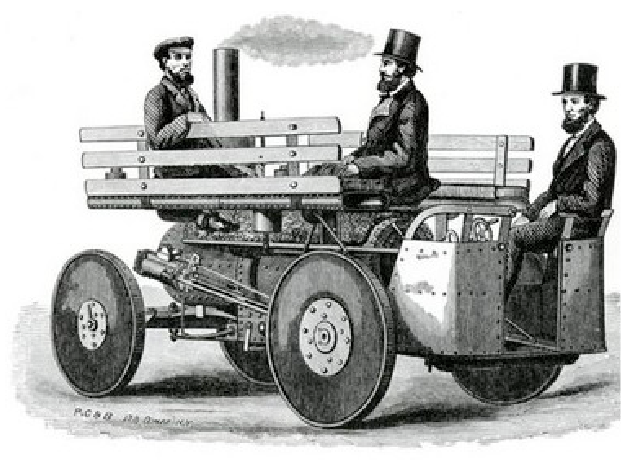1850
STEAM DRIVEN traction engines were hauling passenger coaches in Paris
and Bordeaux years after the British road transport industry had been crippled by discriminatory legislation. Continental designers, unhampered by public prejudice and draconian legislation, took over Britain’s lead in the field of road transport. They would hold onto that lead well into the petrol era. But not to worry; we caught up.
A SUBMARINE telegraph cable was laid between Dover and Calais; the water was kept out by gutta percha (a form of rubber). And you can’t run a motorcycle in British weather without waterproof wiring, can you?
1853
RICHARD DUDGEON, who had emigrated from Scotland to the USA, built an eight-seat steam carriage which was exhibited at industrial show in New York. It was destroyed when the exhibition hall burned down so Dudgeon started again and built another. Water tanks were mounted under the seats and passengers rested their feet on the boiler, so presumably heating was no problem, except in the summer. It had a cruising speed of 30mph and was more like a car than a coach. The USA was not affected by the anti-steam prejudice that blighted British designers and operators.

1854
IN THE USA JK Fisher of New York built a small steam carriage that could do 15mph on smooth surfaces but was too flimsy for rough roads. Right vehicle, wrong place, wrong time.

HENRI SAINTE-CLAIRE Deville made aluminium in bulk. It had cost more than gold or platinum but the price dropped by 90% within 10 years. Mind you, it was still too expensive for widespread use.
FATHER EUGENIO Barsanti of the Piarist Fathers of Scolopi and hydraulic engineer Felice Matteucci patented a hydrogen engine in London (they chose London as Italian law offered little patent protection). A prototype was built in the 1860s, leading some Italians to claim Barsanti and Matteucci invented the internal combustion engine. Schifezza!

JOHN RAMSBOTTOM developed split piston rings which maintained a seal by outward spring tension on the cylinder wall. He later became president of the Institute of Mechanical Engineers.
AUSTRIAN ABRAHAM Shreiner built a distillation plant to produce petrol from crude oil as a fuel for lighting. Petrol was also used as a cleaning fluid.
GERMAN M DAVIDSON took to the streets of Darmstadt in a cart powered by an electric motor. Battery technology was too primitive to make it practicable.
The first steam engine in Japan was a 1-in-4 model presented to the Shogun by Commodore Perry of the US navy.

1855
BIRMINGHAM GUNMAKERS were called upon by the Government to furnish arms for use in the Crimea. The consortium they set up was called Birmingham Small Arms and, as all right thinking motorcyclists know, BSA, as well as becoming at its prime the largest motorcycle manufacturer in the world, produced some of the best motorcycles. NB Modern histories cite 1861/2 as the launch date. The 1855 date is taken from B.S.A. History from the Days of the Crimea to the Great War, published by BSA in 1916. The BSA factory opened in 1862, which might account for the later date.

1858
THE STEAM COACHES of the 1830s had been killed off by the horsey set and railways ruled the roost. But after a couple of decades a few exceptionally rich enthusiasts decided they’d like horseless carriages. The Marquis of Stafford engaged one Thomas Rickett to produce a steamer. The Engineer reported: “Lord Stafford and party made another trip with the steam carriage from Buckingham to Wolverton. His lordship drove and steered, and although the roads were very heavy, they were not more than an hour in running the nine miles to Old Wolverton. His lordship has repeatedly said that it is guided with the greatest ease and precision. It was designed by Mr Rickett to run ten miles an hour. One mile in five minutes has been attained, at which it was perfectly steady, the centre of gravity being not more than 2ft from the ground. A few days afterwards this little engine started from Messrs. Hayes’s Works, Stoney Stratford, with a party consisting of the Marquis of Stafford, Lord Alfred Paget, and two Hungarian noblemen. They proceeded through the town of Stoney Stratford at a rapid pace, and after a short trip returned to the Wolverton railway station. The trip was in all respects successful, and shows, beyond a doubt, that steam locomotion for common roads is practicable.”
